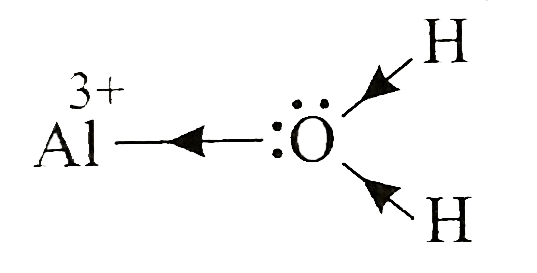The aqueous solution of aluminium chloride is acidic due to the
A
formation of AI(OH)3
B
hydrolysis of cation and anion
C
hydrolysis of anion
D
hydrolysis of cation
Video Solution
Text Solution
The correct Answer is:D
Salts that contain small, highly charged metal cations (for example, AI3+,Cr3+,Fe3+,Bi3+, and Be2+) and the conjugate bases of strong acids (e.g, CI−) produce an acidic solution because these cations hydrolyze to produce excess hydronium ions. Consider aluminium chloride (AICI3) as a typical example. When solid anhydrous AICI3 is added to water, the becomes very warm as the AI3+ ions become hydrated in solution to form the hydrated ion [AI(H2O)6]3+. Each of these species is octahedral, meaning that the metal ion (AI3+) is located at the center of a regular octachedron, and the O atoms in six H2O molecules are located at the corners. Consider one bond between the metal ion and the oxygen atom of one of the six water molecules in [AI(H2O)6]3+:

The attraction of the small AI3+ ion for the lone pairs on the oxygen atoms is so greater that in the metal-oxygen bonds of the hydrated cation, electron density is decreased around the O end of each H2O molecule (as AI3+ ion draws electron density towards itself). The O atom in turn draw electron density of the O−H bond toward itself. This weakens the O-H bonds in coordinated H2O molecules relativer to the O-H bond in noncoordinated H2O molecules. Consequently, the coordinated H2O molecule H2O molecule can donate H+ to the solvent H2O molecules to form H3O+ ions. This produces acidic solutions. The equation for the hydrolysis of hydrated AI3+ solutions. The equation for the hydrolysis of hydrated AI3+ is written as follows:
[A(H2O)6]3□(aq.)+H2O(I)⇔[AI(OH)(H2O)5]2+(aq.)H3O+(aq.)
or simply [AI(H2O)6]3+(aq.)⇔[AI(OH)(H2O)5]2+(aq.)+H+(aq.)
The hydrolysis of hydrated small, highly charged cations may occur beyound the first step, i.e., the [AI(OH)(H2O)5]2+ species can undergo further ionization as
[AI(OH)(H2O)2+5](aq.)⇔[AI(OH)2O)4]++H+(aq.) and so on. The extent of hydrlysis is the greatest for the smallest and most highly charges ions because a compact highly charged ion is more effective in polarizing the O-H bond and facilitating ionization. This is the reason that relatively large ions of low charge such as Na+ and K+ do not undergo hydrolysis.
|
Updated on:21/07/2023
Topper's Solved these Questions
- BOOK - R SHARMACHAPTER - EQUILIBRIUMEXERCISE - Follow-up Test 1310videos
EQUILIBRIUM
- BOOK - R SHARMACHAPTER - EQUILIBRIUMEXERCISE - Follow-up Test 1412videos
EQUILIBRIUM
- BOOK - R SHARMACHAPTER - EQUILIBRIUMEXERCISE - Follow-up Test 1116videos
EQUILIBRIUM
- BOOK - R SHARMACHAPTER - CLASSIFICATION OF ELEMENTS AND PERIODICITY IN ELEMENTSEXERCISE - ARCHIVES37videos
CLASSIFICATION OF ELEMENTS AND PERIODICITY IN ELEMENTS
- BOOK - R SHARMACHAPTER - GENERAL ORGANIC CHEMISTRYEXERCISE - Archives36videos
GENERAL ORGANIC CHEMISTRY
Similar Questions
Knowledge Check
- Question 1 - Select One
Aluminium chloride is a/an
ABronsted-Lowery acidBArrhenius acidCLewis acidDLewis base - Question 2 - Select One or More
Why is a solution of aluminium chloride acidic?
AChloride ions react with water to form hydrochloric acidBAluminium ions have a large charge/surface area ratioCThe H−O bonds are weaker in
[Al(H2O)6]3+ than in H2ODThe H-O bonds are stronger in
[Al(H2O)6]3+ than in H2O - Question 3 - Select One
Aqueous solution of sodium chloride is called.
AbrineBmilk of magnesiaCwashing sodaDbaking soda
Assertion : An aqueous solution of ferric chloride is acidic due to hydrolysis.
Reason : Ferric chloride is a covalent compound and exists as a dimer.View SolutionOf the following statements which is true?
(i) Baeyer's process is employed for purification of bauxite containing silica
(ii) All the Al−Cl bonds in Al2Cl6 are equivalent
(iii) An aqueous solution of aluminium chloride is acidicView SolutionAluminium chloride exists as a
View SolutionThe aqueous solution of AlCl3 is acidic due to the hydrolysis of
View SolutionThe aqueous solution of potash alum is acidic due to hydrolysis of
View Solution

